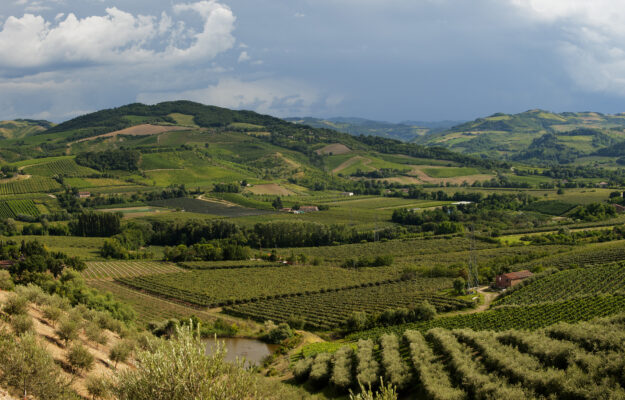In general, heavy spring rains and downy mildew characterized the 2023 harvest in Italy (and National estimates revised downwards, from -12% initially estimated, to -20%, -24%, updated after the anomalous performance in September Assoenologi, ISMEA and Unione Italiana Vini). However, there are those who fared even worse, such as Emilia Romagna, which had to deal also with a tragic flood, around mid-May, when 350 million cubic meters of water fell in just a few days, creating devastating damage. Be that as it may, the Region, which is ranked number 5 among the Italian Regions, in value exported, reached 452 million euros in 2022, according to the Italian statistics institute, ISTAT data. In spite of all the damage the wineries were subjected to as well, the Region will remember 2023 as a good year in terms of quality.
“The wine sector in Emilia-Romagna counts 2.753 wineries, and its heritage boasts 53.000 hectares of vineyards managed by 16.000 companies”, the wine consortium of Romagna, Consorzio Vini di Romagna, explained (to whose producers of wines from Sangiovese di Romagna to Albana, among others, in a few weeks we are dedicating a special issue of our newsletter of monographs on wine territories, “I Quaderni di Winenews”, ed.), “and a significant number, especially in the Romagna area, suffered damage due to the flood in May. The greatest and most frequent damage was mainly linked to landslides and the development of downy mildew in the vineyards of hilly areas, where it has not always been possible to treat promptly because the land is not usable. In addition, companies were also damaged because they had to suspend their commercial activity due to the interruption of public roads, for instance, in the areas between Modigliana and Brisighella”.
As far as production is concerned, in this territory that is a “wine mosaic” intertwined with beauty, history, craftsmanship and art, as we have narrated in this video, things went differently in the plains and the hills, where the global production report was quantitatively discreet and qualitatively excellent. The Consortium, as a matter of fact, has indicated stable or a slight increase in production in the vineyards of the lowland areas, in spite of the flooding and various extraordinary events that have affected these areas. In the hilly area, instead, various disasters followed one after another, leading to a significant reduction in production, and a drop compared to the last two harvests, which had been scarce.
“In terms of adversity, 2023 did not save us from anything - a dry winter, followed by sporadic spring frosts”, Roberto Monti, president of the Romagna Wine Consortium, commented, “which affected some valleys and some plains areas. In addition to this, there were intense rains in May and consequent flooding in the plains, and landslides in the hills, which caused direct and indirect damage to the vineyards. In the hilly vineyards, where roads were not usable, or land had caused delays for interventions in the vineyard, the spread of downy mildew and powdery mildew has led to a significant reduction in production, although the damage has not reached levels that have been found in other Regions of Central-Southern Italy. There were also hailstorms, tornadoes and an increasing incidence of golden flavescence. On average, production estimated for hillside companies is between -20% and -25%. Quality, instead, is very good because of the stable and sunny weather during the second part of the summer. The temperature range between day and night registered at the end of August and in the month of September, especially, had a decisive role on the quality of the grapes”. The grapes appeared “beautiful, in perfect health, the right sugar concentration and a good acid balance. Correct winemaking can enhance the characteristics of the production and lead to excellent qualitative results. Data is also positive in vineyards that have higher yields per hectare, and are not intended for PDO production”, Monti explained.
Quality then, besides events such as floods, and the harvest is, everyone agrees, the main road outlining a future for the Region. “The trend in the last few vintages has painted a clear picture indicating that climate change is now a reality that must be faced. The succession of dry seasons and extraordinary events, indicate the only solution is to ensure quality in the vineyard, with a view to enhancing production through designations of origin. This is where the work of the Consorzio is important, as it is constantly present alongside production companies protecting designations of origin, and in communicating and promoting Romagna wines. Even though this has been one of the most difficult years in the last thirty, the activity of the Consortium and the producers is synonymous with guaranteeing quality”.
Copyright © 2000/2025
Contatti: info@winenews.it
Seguici anche su Twitter: @WineNewsIt
Seguici anche su Facebook: @winenewsit
Questo articolo è tratto dall'archivio di WineNews - Tutti i diritti riservati - Copyright © 2000/2025









































































































































































































